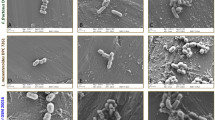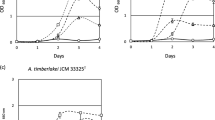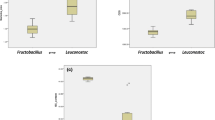Abstract
Fructophilic strains of Leuconostoc spp. have recently been reclassified to a new genus, i.e., Fructobacillus. Members of the genus are differentiated from Leuconostoc spp. by their preference for fructose on growth, requirement of an electron acceptor for glucose metabolism, and the inability to produce ethanol from the fermentation of glucose. In the present study, enzyme activities and genes involved in ethanol production were studied, since this is the key pathway for NAD+/NADH cycling in heterofermentative lactic acid bacteria. Fructobacillus spp. has a weak alcohol dehydrogenase activity and has no acetaldehyde dehydrogenase activity, whereas both enzymes are active in Leuconostoc mesenteroides. The bifunctional alcohol/acetaldehyde dehydrogenase gene, adhE, was described in Leuconostoc spp., but not in Fructobacillus spp. These results suggested that, due to the deficiency of the adhE gene, the normal pathway for ethanol production is absent in Fructobacillus spp. This leads to a shortage of NAD+, and the requirement for an electron acceptor in glucose metabolism. Fructophilic characteristics, as observed for Fructobacillus spp., are thus due to the absence of the adhE gene, and a phenotype that most likely evolved as a result of regressive evolution.


Similar content being viewed by others
Abbreviations
- LAB:
-
Lactic acid bacteria
- FLAB:
-
Fructophilic lactic acid bacteria
- GIT:
-
Gastrointestinal tracts
- ADH:
-
Alcohol dehydrogenase
- ALDH:
-
Acetaldehyde dehydrogenase
References
Endo A, Okada S, Morita H (2007) Molecular profiling of Lactobacillus, Streptococcus, and Bifidobacterium species in feces of active racehorses. J Gen Appl Microbiol 53:191–200
Endo A, Okada S (2008) Reclassification of the genus Leuconostoc, and proposals of Fructobacillus fructosus gen. nov., comb. nov., Fructobacillus durionis comb. nov., Fructobacillus ficulneus comb. nov. and Fructobacillus pseudoficulneus comb. nov. Int J Syst Evolution Microbiol 58:2195–2205
Endo A, Futagawa-Endo Y, Dicks LMT (2009) Isolation and characterization of fructophilic lactic acid bacteria from fructose-rich niches. Syst Appl Microbiol 32:593–600
Endo A, Futagawa-Endo Y, Sakamoto M, Kitahara M, Dicks LMT (2010) Lactobacillus florum sp. nov., a novel fructophilic species isolated from flowers. Int J Syst Evol Microbiol 60:2478–2482
Endo A, Irisawa T, Futagawa-Endo Y, Sonomoto K, Itoh K, Takano K, Okada S, Dicks LMT (2011) Fructobacillus tropaeoli sp. nov., a novel fructophilic lactic acid bacterium isolated from a flower. Int J Syst Evol Microbiol 61:898–902
Endo A, Irisawa T, Futagawa-Endo Y, Takano K, du Toit M, Okada S, Dicks LMT (2012) Characterization and emended description of Lactobacillus kunkeei as a fructophilic lactic acid bacterium. Int J Syst Evol Microbiol 62:500–504
Hammes WP, Hertel C (2006) The genera Lactobacillus and Carnobacterium. In: Dworkin M, Falkow S, Rosenberg E, Schleifer K-H, Stackebrandt E (eds) The Prokaryote, vol 4, 3rd edn. Springer, New York, pp 320–403
He H, Chen Y, Zhang Y, Wei C (2011) Bacteria associated with gut lumen of Camponotus japonicus Mayr. Environ Entomol 40:1405–1409
Hols P, Hancy F, Fontaine L, Grossiord B, Prozzi D, Leblond-Bourget N, Decaris B, Bolotin A, Delorme C, Dusko Ehrlich S, Guédon E, Monnet V, Renault P, Kleerebezem M (2005) New insights in the molecular biology and physiology of Streptococcus thermophilus revealed by comparative genomics. FEMS Microbiol Rev 29:4435–4463
Koo OK, Jeong D-W, Lee JM, Kim MJ, Lee J-H, Chang HC, Kim JH, Lee HJ (2005) Cloning and characterization of the bifunctional alcohol/acetaldehyde dehydrogenase gene (adhE) in Leuconostoc mesenteroides isolated from kimchi. Biotechnol Lett 27:505–510
Neveling DP, Endo A, Dicks LM (2012) Fructophilic Lactobacillus kunkeei and Lactobacillus brevis isolated from fresh flowers, bees and bee-hives. Curr Microbiol 65:507–515
Nomura M, Kobayashi M, Narita T, Kimoto-Nira H, Okamoto T (2006) Phenotypic and molecular characterization of Lactococcus lactis from milk and plants. J Appl Microbiol 101:396–405
Papalexandratou Z, Falony G, Romanens E, Jimenez JC, Amores F, Daniel HM, De Vuyst L (2011) Species diversity, community dynamics, and metabolite kinetics of the microbiota associated with traditional ecuadorian spontaneous cocoa bean fermentations. Appl Environ Microbiol 77:7698–7714
Sambrook J, Fritsch EF, Maniatis T (1989) Molecular cloning: a laboratory manual, 2nd edn. Cold Spring Harbor Laboratory, Cold Spring Harbor
Slattery L, O’Callaghan J, Fitzgerald GF, Beresford T, Ross RP (2010) Invited review: Lactobacillus helveticus-a thermophilic dairy starter related to gut bacteria. J Dairy Sci 93:4435–4454
Thaochan N, Drew RA, Hughes JM, Vijaysegaran S, Chinajariyawong A (2010) Alimentary tract bacteria isolated and identified with API-20E and molecular cloning techniques from Australian tropical fruit flies, Bactrocera cacuminata and B. tryoni. J Insect Sci 10:131
van de Guchte M, Penaud S, Grimaldi C, Barbe V, Bryson K, Nicolas P, Robert C, Oztas S, Mangenot S, Couloux A, Loux V, Dervyn R, Bossy R, Bolotin A, Batto JM, Walunas T, Gibrat JF, Bessières P, Weissenbach J, Ehrlich SD, Maguin E (2006) The complete genome sequence of Lactobacillus bulgaricus reveals extensive and ongoing reductive evolution. Proc Natl Acad Sci USA 103:9274–9279
Vogel RF, Pavlovic M, Ehrmann MA, Wiezer A, Liesegang H, Offschanka S, Voget S, Angelov A, Böcker G, Liebl W (2011) Genomic analysis reveals Lactobacillus sanfranciscensis as stable element in traditional sourdoughs. Microb Cell Fact 30(Suppl 1):S6
Zaunmüller T, Eichert M, Richter H, Unden G (2006) Variations in the energy metabolism of biotechnologically relevant heterofermentative lactic acid bacteria during growth on sugars and organic acids. Appl Micobiol Biotechnol 72:421–429
Acknowledgments
The authors are grateful to Dr. S. Deane (University of Stellenbosch) for assistance on the Southern blot hybridization and to Prof. Y. Niimura and Dr. S. Kawasaki (Tokyo University of Agriculture) for valuable advices on determination of enzyme activities. This study was partially supported by the South Africa/Japan Science and Technology Agency Cooperation Programme.
Author information
Authors and Affiliations
Corresponding author
Rights and permissions
About this article
Cite this article
Endo, A., Tanaka, N., Oikawa, Y. et al. Fructophilic Characteristics of Fructobacillus spp. may be due to the Absence of an Alcohol/Acetaldehyde Dehydrogenase Gene (adhE). Curr Microbiol 68, 531–535 (2014). https://doi.org/10.1007/s00284-013-0506-3
Received:
Accepted:
Published:
Issue Date:
DOI: https://doi.org/10.1007/s00284-013-0506-3




